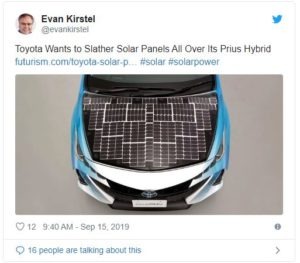Ever thought of decorating your car in patterns? If Toyota succeeds at running its electric vehicle off newly improved solar panels, the dark mosaic grids we usually associate with sunlight-snagging rooves may become the hottest new look for cars.
— Evan Kirstel (@evankirstel) September 15, 2019
We don’t have a fully solar-powered car yet, but we need one. That’s because most cars run on fossil fuels, which contribute to global warming and the destabilisation of climate. Electric Vehicles (EVs) run off plugs (like your kettle does), can be conveniently charged at home, and are punted as the eco-friendly alternative. If the energy used to charge it is not clean energy, however, running your EV still compromises the earth’s natural systems by contributing to greenhouse gasses that are causing climate change. Toyota is testing a way to change this. The first one hundred percent sun-driven car might soon be a reality.
Toyota is exploring a design for a self-charging solar solution. These panels are only 0.03mm wide, which means they’re pliable enough to fit the contours of the Prius snugly. The photovoltaic panels from Sharp Corp are positioned permanently on the bonnet, roof, back window, and spoiler (tail or fin on the boot).
It’s not the first time the Japanese automobile giant has put panels on a car in its catalogue, but the Prius model’s predecessors offered limited solar power because they couldn’t charge while moving. This model can.
And it won’t be the only car driving on sun juice here on earth. Futurism reported earlier this year that a Dutch company has already launched the first long-range, sun-powered vehicle. The Lightyear One boasts a full 5 square metres of panels on its body and runs for a whopping 725 km on a single charge. Problem is, you have to charge it for 2,5 days to fill the battery, and if the sun doesn’t shine between stops and your battery is about to die, you have to find an EV charging station or fill up with regular fuel.
The Prius promises more because it charges while it drives, where the One doesn’t. “On a good day,” notes Reuters, “the [stationary] charge can be sufficient for up to 56 kilometres of travel, more than the 47 kilometres driven a day by the average American, according to a study by the AAA Foundation for Traffic Safety.”
It’s not, of course, more than you might actually want to travel on a day, so you can see why we’re still a ways off from this being a real solution, but it does suggest that our great, burning orb in the sky may soon be making a huge dent in the green guilt we get every time we drive. Together. With aircon off. At slower speeds. Because this is better for the environment[1]. Otherwise take a bus or a bicycle. Not a whole lot of freedom in the ways we can currently mitigate our private journeys’ carbon footprint, is there?
A self-charging car is freedom perfected. Less environmental guilt when you change gears, no need to plug in for hours, no need to queue up at charging stations at rush hour. Until the technology allows the vehicle to run entirely off its own panels, however, we’ll still have to stop to recharge.
Interesting aside: There’s also talk of harvesting the sun’s energy from farms floating in space, where sunlight is a constant, which raises capacity and lowers cost. We may have more charging stations sooner on terra firma as the supply grows at gargantuan proportions (2000 gigawatts of power compared to the current 1.8). Forbes says that it was first imagined in the 40s, explored but abandoned due to extreme costs in the 70s, and is now being explored again as technology evolves and cost prices drop. But we’re still about as far away from beaming energy through the atmosphere to anywhere on earth as we are to powering a Prius on a bit of suntanning.
In the interim, the answer lies in charging EVs in homes and charging stations that run off solar. South Africa burns coal for power and solar is not yet the norm. But it’s on its way, as McKinsey & Company[2] points out. If we can get it right, the future looks bright, and full of patterns 😊.
More
- Until that solar Prius is available, here are a few ways to be more environmentally responsible with your car.
- This car company aims to be carbon neutral by 2039.
- Solar is sexy, but how about a completely quiet car?
- Uh oh. Pet food production takes its toll on the earth’s ecologies, too. Here’s how to feed the dogs more sustainably.
[1] https://www.dotsure.co.za/8-ways-to-go-greener-with-your-car/




